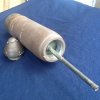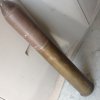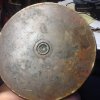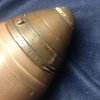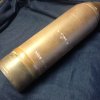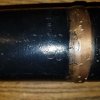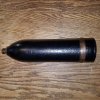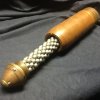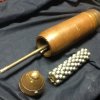I received this today and believe it to be a US " Common 3" Shrapnel Shell". I decided I needed one to round out the collection. The only minus would be it appears the body has been painted in a brownish primer. Markings: Fuze, " FA Model 1907M, 733511s, Lot 163 ( XX over stamped) 17". Case: " 75mm FG BH-1950-18, crossed cannon, AM LOT 765-244H". Primer: " US 18 14??-25". Projectile: base has a flaming bomb. Body, " L6180 X V", and 7898 45 , a circle with an "S" in it, and partial flaming bomb". Am I correct in my ID?. All comments appreciated.
British Ordnance Collectors Network
You are using an out of date browser. It may not display this or other websites correctly.
You should upgrade or use an alternative browser.
You should upgrade or use an alternative browser.
Common US 3" Shrapnel round, WW1 ?
- Thread starter 917601
- Start date
Hazord, I flubbed it up, I meant 75mm. M8, nice specimens. Can anyone supply me with the diameter of lead balls that went in this. Since it has the pusher tube, I would like to fill it with lead? Balls ( shrapnel), close as possible to original size. I want to assemble balls so when the pusher tube is pulled out, a few partial rows can be viewed.
917601, As you stated, you have 75mm Shrapnel round. A point of clarification would be that it is not a "Common". A Common would be more of the shape as the WWI 2.24" (6Pdr FG) Tank Gun Round (base fuzed) pictured above of the 3" HE.
Nice that it has the flash tube and pusher plate. The size of the balls used were nominally .45" dia. Cheers, Bruce.
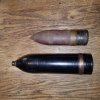
Nice that it has the flash tube and pusher plate. The size of the balls used were nominally .45" dia. Cheers, Bruce.

Last edited:
917601, As you stated, you have 75mm Shrapnel round. A point of clarification would be that it is not a "Common". A Common would be more of the shape as the WWI 2.24" (6Pdr FG) Tank Gun Round (base fuzed) pictured above of the 3" HE.
Nice that it has the flash tube and pusher plate. The size of the balls used were nominally .45" dia. Cheers, Bruce.
View attachment 151136
Hello,
Very interesting.
Do you have other pictures with details of these two nice shells ?
Regards
917601, As you stated, you have 75mm Shrapnel round. A point of clarification would be that it is not a "Common". A Common would be more of the shape as the WWI 2.24" (6Pdr FG) Tank Gun Round (base fuzed) pictured above of the 3" HE.
Nice that it has the flash tube and pusher plate. The size of the balls used were nominally .45" dia. Cheers, Bruce.
View attachment 151136
Ba, were the shrapnel balls lead? I can find .50 cal lead balls easy enough. Secondly, any ideas as to how my shell " came to be"? The pusher plate is a larger diameter than the opening and is not fully removable. That leads me to believe it was assembled but never filled with the balls and matrix compound. The interior cavity is clean metal. A factory rejection? Or, maybe the filling was "boiled out"? I read someplace that was done in those days to inert live ones.
Last edited:
917601, The ring around the nose of the shell is also a fuze adapter and screwed (it was slightly tapered) in to the body after filling. Once the lead balls and sulfur/pitch matrix is loaded, they are pressed in and another thin disk is placed over that. There is a hole on the disk that sldes over the flash tube and then is swaged on (which allows the flash from the fuze to travel down the tube to the base charge) then the fuze adapter is screwed on.
The balls are lead. As far as .45 balls, you can get the .44 lead balls for the .44 Remington M1858 or Colt .44 black powder pistols. They are usually .45" anyway and I think that's why the Army used them. Cheers, Bruce.
The balls are lead. As far as .45 balls, you can get the .44 lead balls for the .44 Remington M1858 or Colt .44 black powder pistols. They are usually .45" anyway and I think that's why the Army used them. Cheers, Bruce.
MINENAZ16, I have no other information on them then that they exist. When doing a clearance of a WWI Range in Pennsylvania, we encountered many of the fired 3" rounds, Common, HE and Shrapnel, along with the 75mm and 155mm HE's and Shrapnels. The unfired one pictured I found at a gun show later. The 2.24" looks to be a Costal Artilllery round repurposed for our copies of the British Male Tank. Its casing is originally marked (US) 6Pdr RFG then overstamped 2.24" TANK GUN MK. II B.R. P.A. 8999-2 (lot number). Cheers, Bruce.
I found the .451" lead balls, 98 each made one row thick,( 7 balls in a layer) 13 high per drawings. Epoxied them around a suitable tube. The tube slides down over the pusher plate rod. For those that like to disassemble Ordnance...it illustrates the shrapnel shell design just fine...getting heavy tho.
Attachments
Last edited:


